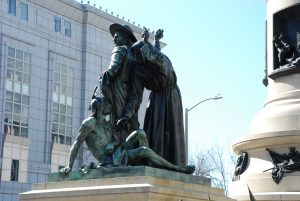
My interest in pioneer monuments began with the dozens of statues of pioneer mothers in sunbonnets. Pioneer Mothers appeared across the United States, including the bronze sculpture by Charles Grafly that now stands in Golden Gate Park. Trained as a western gender historian, I set out to write a book that compared depictions of frontier women in different western states. But the more I researched San Francisco’s Pioneer Mother statue, the more I realized that this story was much bigger than the one that I set out to tell. San Francisco socialite Ella Sterling Mighels was inspired to create a statue honoring San Francisco’s pioneer mothers when she observed earlier frontier-themed monuments such as the 1894 Pioneer Monument and 1897 Admission Day Monument towering over the city’s smoldering ruins in the aftermath of the massive 1906 earthquake. Although no sunbonneted pioneer mothers appear on either of those monuments, I realized that I needed to expand the scope of my research to them.
|
|
| Pioneer Monument, Hyde & Grove, 1993 |
Researching San Francisco’s Pioneer Monument forced me to expand my chronological focus. Digging into newspaper accounts looking for public reactions to the monument revealed that attitudes had changed over time. Although it was lauded in San Francisco and across the nation when it was erected in the 1890s, it became highly controversial when the city sought to move it in the 1990s. And then, as controversy erupted around Confederate commemoration in 2015, San Francisco’s Pioneer Monument once again became the subject of public debate. My focused study of pioneer mother monuments from the 1920s ultimately became a sweeping study of pioneer commemoration over more than 125 years from 1890 to the present.
 |
| Pioneer Monument, 1908 |
Delving into WHY the Pioneer Monument became controversial in the 1990s forced me to expand my theoretical focus. Its donor, gold rush migrant-turned-eccentric millionaire James Lick, called for the monument to represent California history from Spanish missions through the growth of American agriculture and commerce. In other words, the monument was to celebrate white American conquest of California. Sculptor Frank Happersberger’s depiction of the mission period has proved most controversial. In “Early Days,” a Spanish missionary towers over a passive American Indian at his feet. In the background, a Mexican vaquero swings a lasso (now missing). Other design elements reinforced the message that Spanish and Mexican settlement had paved the way for the triumph of white American agriculture and commerce.
|
|
| Pioneer Mother, Panama-Pacific International Exposition, 1915 |
Understanding the centrality of racial hierarchies depicted in the 1894 Pioneer Monument changed how I thought about pioneer mother monuments, as well. Donors’ objections to depicting San Francisco’s Pioneer Mother wearing a fringed buckskin dress and moccasins took on new meaning as I realized that pioneer mother monuments erected in the early 20th century sought not only to honor settler women’s sacrifices on the frontier, but to celebrate their role in racial conquest of the American West. The variations in gender depictions that I originally set out to study were in fact just a small part of a much larger story about changing race relations in San Francisco and throughout the West.
This blog entry originally appeared on the San Francisco Public Library’s San Francisco History Center / Book Arts and Special Collections Blog, “What’s on the 6th Floor?” (posted July 25, 2018).


